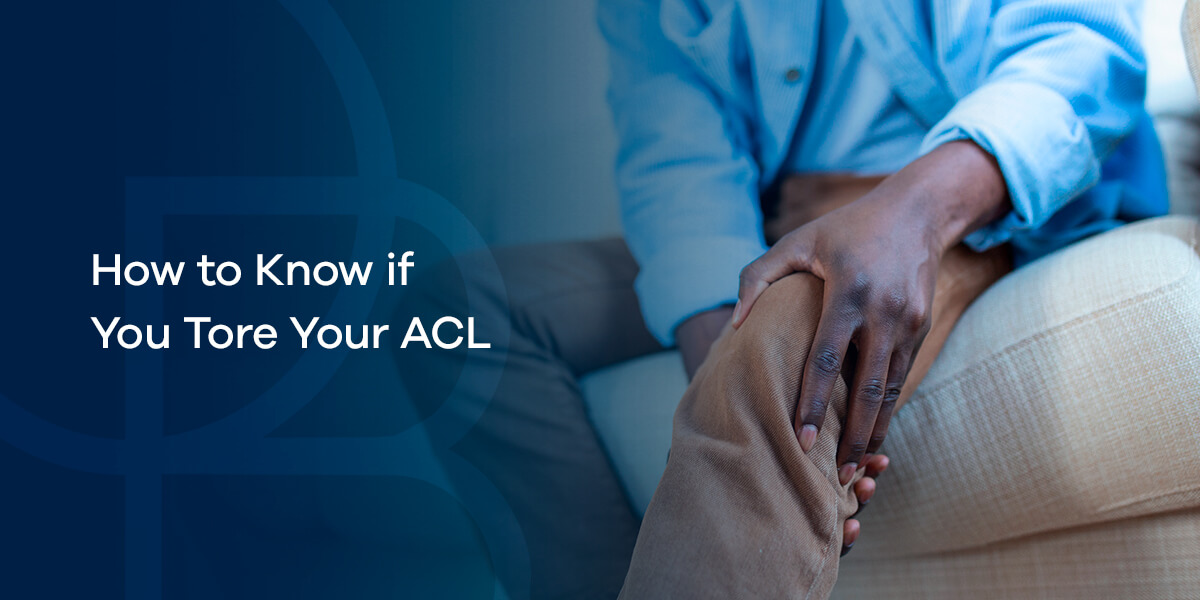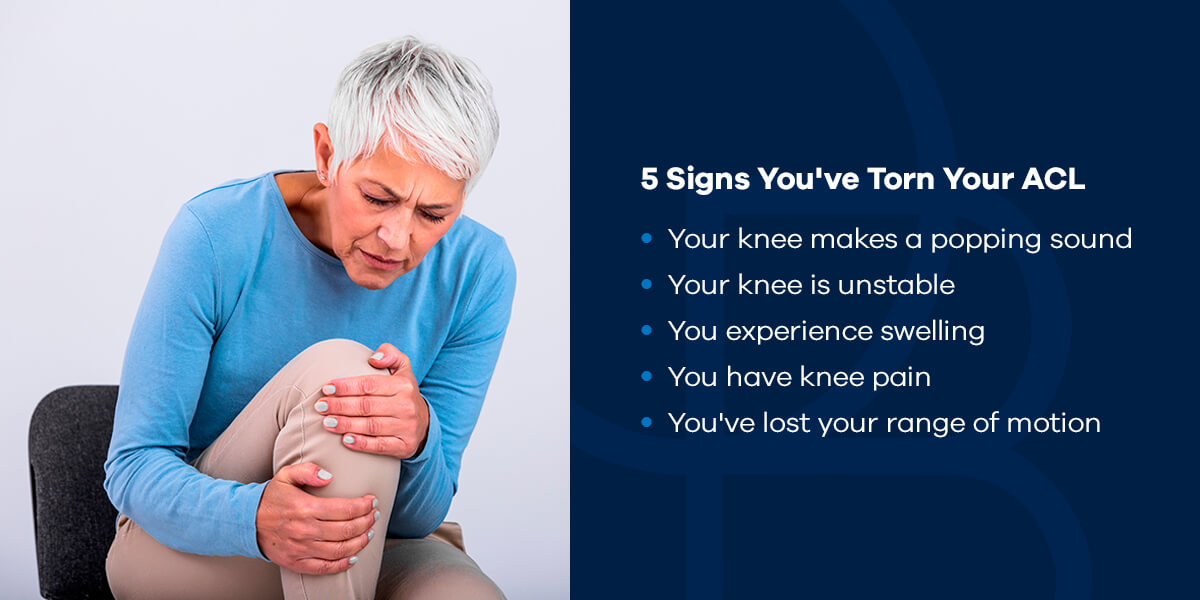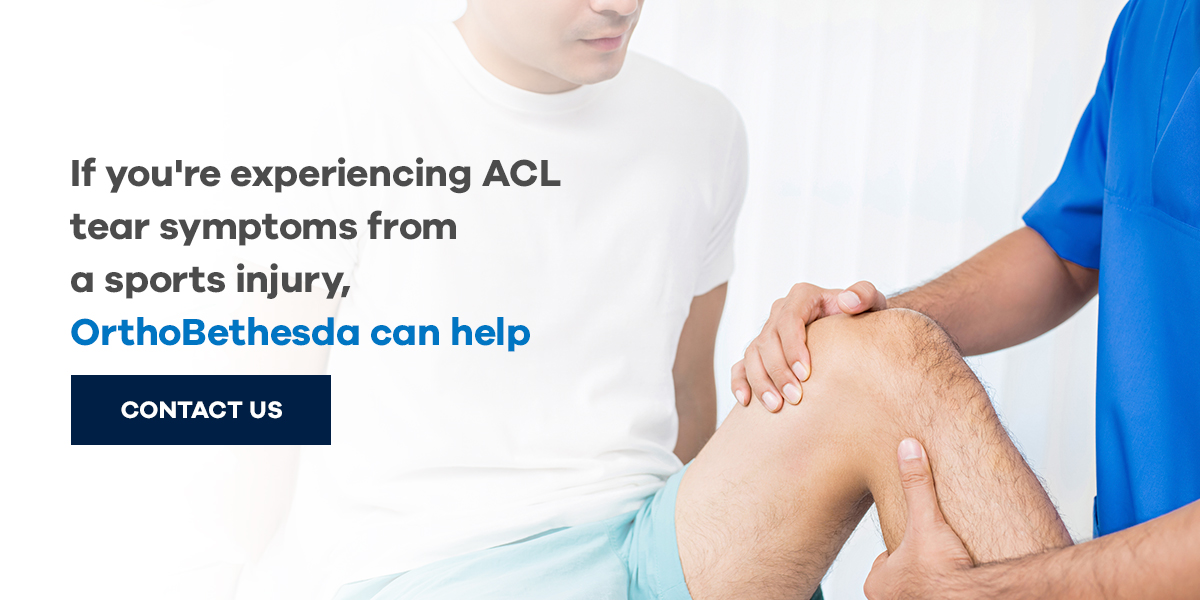
The anterior cruciate ligament (ACL) is a crucial ligament in your knee that helps stabilize the joint. Tearing or spraining your ACL can cause pain, instability, lack of motion and swelling.
Most people who experience an ACL injury do so while playing a sport that requires jumping, landing or changing directions quickly, such as soccer, football, basketball or skiing. Athletes can also tear their ACL if their knee can no longer bear their weight or if they come in direct contact with someone, which is common in tackling sports like football.
An ACL tear can either be complete or partial, depending on the extent of the tear. A sprained ACL occurs when the ligament gets overstretched but hasn’t reached the point of tearing. Learn more about how you can identify a torn ACL below.

5 Signs You’ve Torn Your ACL
Most people know right away that they’ve torn their ACL. Some of the signs to look out for include the following:
- Your knee makes a popping sound: When you tear your ACL, you’ll likely hear a loud popping sound followed by an instant shift in the knee joint. Sometimes, the popping sound is so loud that people in the stands of a soccer or football game can hear it.
- Your knee is unstable: People with an ACL tear will experience instability in the knee since the ligament can no longer stabilize the joint. Your knee can give out from a torn ACL, especially if the injury occurred from a pivoting or cutting movement common to many sports.
- You experience swelling: Like many athletic injuries, an ACL tear will swell near the affected joint. Since the knee joint is one of the largest in the body, the swelling can become large. Swelling occurs when the blood vessels that supply blood to the ligament rupture. A torn ACL may feel warm to the touch and appear red.
- You have knee pain: One of the most common signs of an ACL tear is pain, though the intensity varies from person to person. Some people feel intense pain if the injury is severe. Others will feel pain from the ruptured blood vessels and swelling. The pain may get worse when you put pressure on the joint.
- You’ve lost your range of motion: Since the ACL supports the knee joint, many people who’ve torn their ACL will find it difficult to move their knee or lower leg due to the swelling. Many people with an ACL injury experience walking difficulties and have to use crutches, sticks or walkers to help them get around until the injury has healed.
Risk Factors and Prevention
Some factors can increase your risk of tearing your ACL, including the following:
- Poor conditioning
- Participation in specific sports, such as football, soccer, gymnastics and skiing
- Wearing improperly fitting footwear
- Using poorly maintained sports equipment
- Playing sports on artificial turf
Women are also more susceptible to ACL injuries due to differences in muscle strength, anatomy and hormones.
While people who play sports or perform activities that require pivoting or cutting movements are at a higher risk of developing an ACL injury, there are methods you can use to prevent a tear. Proper training and exercise can help reduce the risk of injury. Working with a professional like an athletic trainer or sports medicine physician can also help reduce the risks. Some methods of prevention include:
- Core strengthening exercises that aim to prevent inward knee movement during squats.
- Training to learn the proper knee position when jumping and landing.
- Leg strengthening exercises to improve balance.
- Training to improve technique for cutting and pivoting movements.knee may give out when the ACL gets torn.
When to See Your Doctor
You should see seek immediate medical care if you have a knee joint injury or your child says, “I think I tore my ACL.” The knee joint is very complex, and all of its parts play a role in helping your walk and balance.
Typically, you should see a doctor if you notice you have:
- Difficulty walking or standing on the injured knee joint.
- Swelling or pain that remains for over 48 hours.
- Trouble supporting your weight on the injured knee.
- An odd appearance on any side of the affected knee.
A doctor may look at noninvasive treatment methods before resorting to surgery. If you have to have ACL surgery, your doctor will guide you through the process and the recovery instructions to help improve the outcome of your treatment.
Get Treatment for an Injured Knee Today
If you’re experiencing ACL tear symptoms from a sports injury, OrthoBethesda can help. One of our highly skilled orthopedic doctors can speak to you over the phone, or you can come over to OrthoBethesda in person for a thorough examination, diagnosis and treatment. Our team curates your treatment to your needs, helping you find relief and get back on your feet. Contact us today to learn more about how we can help you recover from an ACL injury!
Related Content
- How to Prevent ACL Injuries
- Top 7 Stretches to Relieve Knee Pain for Athletes
- Why Knee and Joint Pain Increase When It’s Cold
- Why Your Knee Hurts When You’re Sitting
- How to Lose Weight With Knee Pain
- Is Walking Good for Arthritis in the Knee?
- Bilateral Knee Replacement Recovery Tips
- How Much You Should Walk After a Knee Replacement
- Robotic vs. Traditional Knee Replacement Surgery
- Best Positions to Sleep in After a Knee Replacement
- Stiffness After Knee Replacement Surgery
- What to Avoid After Knee Replacement
- Is There a Best Time of the Year to Schedule Knee Surgery?
- What to Expect After a Total Knee Replacement
- What to Expect After Arthroscopic Knee Surgery
- How Long Does It Take for a Torn Meniscus to Heal Without Surgery?

